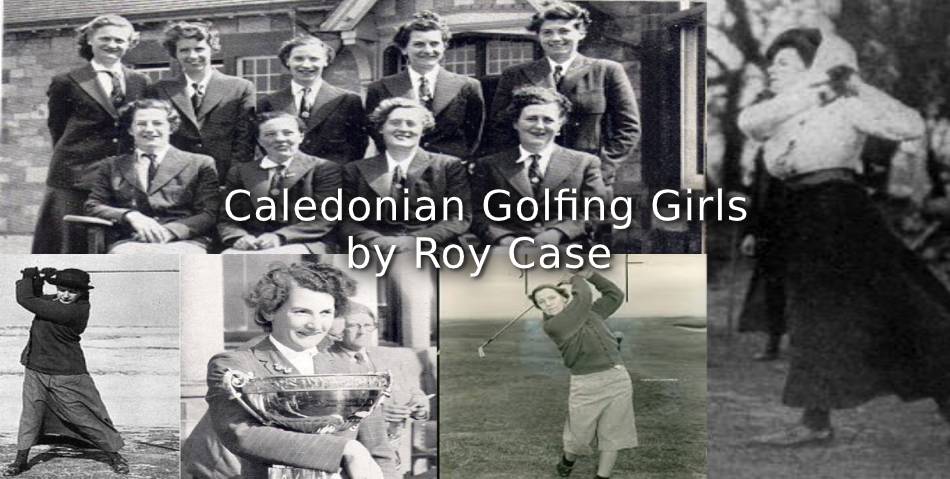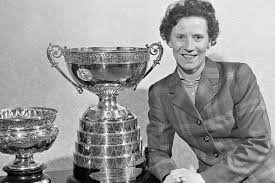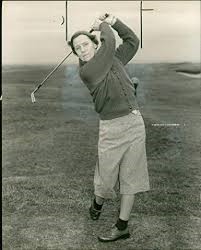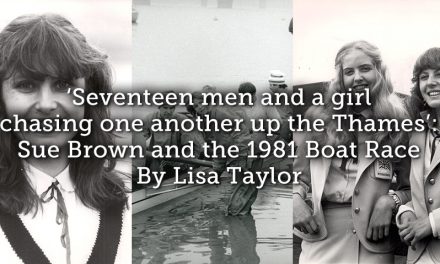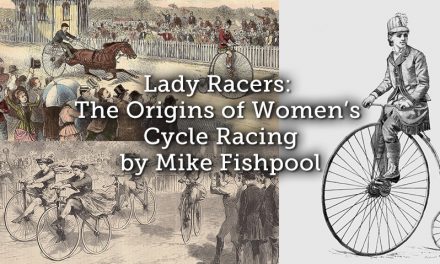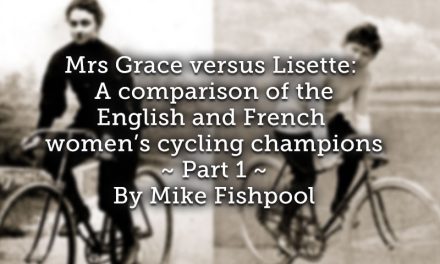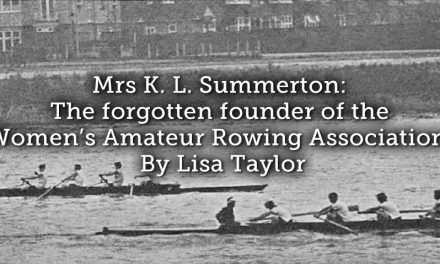The intrinsic practice historically found in almost all forms of sport, has been the inequality afforded to its female participants.
Fashioned through its Scottish heritage the game of golf is played throughout the world. Although initially the implicit understanding was that golf was for ‘gentlemen only, ladies forbidden’, and women were generally banned from entering most clubhouses until the 20 century. Nevertheless the involvement of women in the game goes back much further than some of us might think. For it is implied Caledonian women played stick and ball games as early as the 15 century.
As long ago as 1567, the Queen of Scots, Mary Stuart, [1542-1587], was accused of playing golf at Seton House, Longniddry, only a few days after the murder of her second husband, Lord Darnley [1545-1567], at Kirk o’Field, Edinburgh. In which her antagonists claimed she was implicated.
Tradition has it Queen Mary once lost a golf match to her lady in waiting, Mary Seton, whose family home was Seton House, a popular retreat of the Queen, close by the Firth of Forth a few miles from Musselburgh. After which the Queen presented her with a necklace which was later sold at Christie’s auction house in London in 1894 for £365.
An avid golfer, from time to time, Mary took an infrequent trip to France to enjoy the occasional game. For which she was soundly criticised by her challengers for neglecting her Royal duties. After commonly addressing her helpers as ‘cadets’, she is credited as conceiving the expression ‘caddie’, to describe the person allocated with the task of carrying the player’s clubs.
Queen Mary relished a game of golf, despite the burdensome heavy dresses women wore at the time, But even more outrageously she once played tennis in Falkirk in men’s breeches !

Mary, Queen of Scots, playing golf at St. Andrews.
Source: Illustrated News 1905
The first reliable account of women playing golf In Scotland was published in an edition of the Edinburgh newspaper the Caledonian Mercury in 1738. In which it reported details of a match played between two married women, with their respective husbands acting as caddies. The women were complimented on their ‘dexterity’ in holing out, and how manfully they ’tilted’ the balls [sic]. The paper reported the match was held over the Bruntsfield Links, one of the earliest known golfing locations in Scotland, and attracted a considerable crowd, as was typical of the day, and that a significant amount of gambling took place. Sadly the identity of the competitors remains unknown, other than that the contest was won by the ‘charming Sally’, making her the first ‘named’ woman golfer, but only by her given name ! The event was seemingly forgotten for almost three hundred years, although it was clearly regarded as significant at the time since other newspapers published in London, Pennsylvania and Carolina reproduced the report.
More than half a century later in 1791, it is alleged fishwives played golf on the links at Musselburgh, East Lothian, where the wives of the fishermen of Musselburgh and Fisherrow played an annual competition on New Year’s Day. Archives also record that in 1795 a clergyman, and ardent golfer from the village of Inveresk, south of Musselburgh, maintained women who worked in the fishing industry from the neighbouring village of Fisherrow, were playing golf on their days off. He further claimed the women ‘do the work of men’, and were regularly seen playing both golf and football.
And yet it was not until over 200 years ago, on the 9 January 1811, that the first structured women’s golf tournament took place over the Old Course in Musselburgh, once again between the wives of the local fishermen from Musselburgh and Fisherrow. The event, which was organised by the Musselburgh Golf Club, took place over eighteen holes on the club’s pitch and putt course. And as reward for their effort, the winner was presented with a shawl and a creel, a wicker basket for holding fish. While the runner up received two blue silk handkerchiefs from Barcelona. Undoubtedly there was always a plentiful entry for the ‘Creel Trophy’ when the industrious fisherwomen, were ‘ladies for the day’. Sadly, as before, their identities were never recorded. Moreover, in the nearby village of Dirleton approximately 20 miles east of Edinburgh, ‘weavers’ also traditionally played golf on Handsel Monday, which was celebrated in Scotland on the first Monday after New Year’s Day.
As the sixth oldest golf club in the world, the Musselburgh Old Course was one of three founding venues for The Open Championship, together with Prestwick on the west coast of South Ayrshire, and St Andrews. The Championship was held over the Musselbrough course six times between 1874 and 1889, which at the time was shared with other notable clubs, including the Bruntsfield Links Golfing Society, and the Honourable Company of Leith Golfers until 1891, when it departed in favour of Muirfield.
Run by the Honourable Company of Edinburgh Golfers, the Muirfield Golf Club dates back to 1744, and was the founding source of the written Rules of Golf. Since 1891 it has been located in Gullane, about 20 miles northeast of Edinburgh, and is now one of only ten clubs approved by the Royal and Ancient to host the Open Championship.
Golf has been played on the links at St Andrews since around 1400 AD, with the ‘Old Course’ renowned throughout the world as the ‘Home of Golf’. In 2014, 85 percent of the members of the Royal and Ancient Golf Club of St Andrews voted to bring an end to its all-male policy, and agreed to accept women as members, and offered membership to seven prominent women golfers in the following year.
As a consequence in 2016 the Royal and Ancient stripped the Muirfield Golf Club of its rights to hold the Open Championship, after the club failed marginally to obtain the two-thirds majority required to allow female golfers to join its ranks. A year later, a blustery wind blew across the old links, when the captain of the Honourable Company of Edinburgh Golfers, announced the result of a second ballot of its members to admit women. It transpired the wind of change had blown through the archaic club, for 93 percent of the Muirfield membership turned out to vote, with 80 percent voting in favour of allowing mixed membership, and recommending a modernisation of the club rules. Twelve women were eventually invited to join the club, prior to the subsequent celebration of its 275th anniversary.

Muifield Golf Club
The formation of women’s golf societies began in the last quarter of the 19 century, following which there was an eruption in the appeal of golf for women. And yet it was only recently, that the members of the oldest golf society in the world, the Royal Burgess Golfing Society, founded in 1735, opened up its membership to women. The green light for women at Royal Burgess was switched on in April 2020, a year and half after its near neighbour, the Bruntsfield Links Golfing Society, founded in 1761, took a similar decision.
Ultimately, on New Year’s Day 2017, the business operations and staff of the Ladies’ Golf Union were integrated within the Royal and Ancient group of companies and the merger with the LGU and the R & A came into effect. .
In celebration of the move towards equality within the sport of golf, let us examine the achievements of a trio of Caledonian women who in their day dominated the sport against all odds.
Dorothy Lee Campbell [1883-1945]:
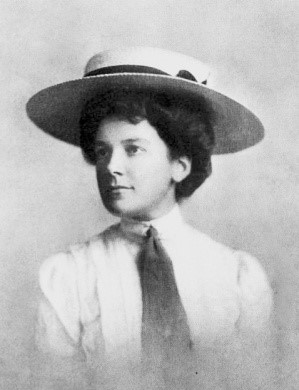
A pupil of the great golf professional Ben Sayers [1856-1924], Dorothy Lee Campbell was the first Scottish woman to create a stir on the international golf scene.
Born into a golfing family in North Berwick, Dorothy was a Scottish golfer who first began swinging a golf club at the tender age of 18 months. Along with her sisters they joined the North Berwick Ladies Golf Club in 1896, where within a few years Dorothy was easily holding her own against the adult members.
When competing in the 1909 British Ladies Amateur Championship at Royal Birkdale, Lancashire, Campbell forgot to report the result of her third round match, which she had won on the 11 green. The officials of the LGU met, and after giving due consideration to her plight, generously decided to allow her to play-on in the championship, which Dorothy went on to win, defeating Ireland’s Florence Eugenia Hezlet [1884-1945] in the final by 4 and 3. The victory earned her an invitation to play in the USA, and subsequently changed the course of her life. In the 1911 British Ladies Amateur Championship at Royal Portrush, Northern Ireland, she defeated Florence’s sister, Violet in the final by 3 and 2.
Campbell was the first woman to win the American, British and Canadian Women’s Amateur Championships, and over the course of her career won 11 national amateur titles. The last of which came in 1924, when at the age of 41, in the American Championship at the Rhode Island Country Club, she out-classed the American, Mary Kendall Browne [1891-1971], 7 and 6, to become the oldest winner of the Championship.
In 1913 Dorothy married Jack Hurd a member of Oakmont Country Club in Pennsylvania, and went on to win many more of her titles as Mrs. J.V.Hurd. They were divorced in 1923, after which she married Edward Howe in 1937, and they were divorced after six years.
Dorothy died in a railway accident in 1945, when she fell from a platform into the path of an oncoming train.
In 1978 she was inducted to the Canadian Golf Hall of Fame and the World Golf Hall of Fame.
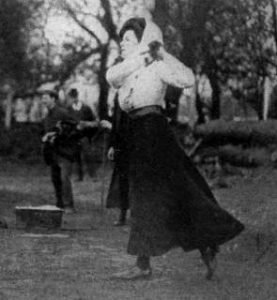
Campbell prior to her 1909 victories
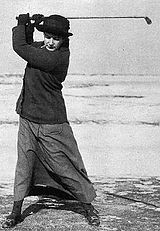
Campbell, circa 1912
Jessie Valentine [née Anderson – 1915 – 2006]:

Born in the The Fair City of Perth, on the banks of the River Tay, Jessie Valentine MBE was a Scottish amateur golfer who remained a dominant force in women’s golf from the 1930s to the 1950s. Jessie won the British Ladies Amateur Championship three times, in 1937, 1955 and 1958. After winning the title at Turnberry, South Ayrshire in 1937, she became the world number one ranked ladies golfer, when as Jessie Anderson, she defeated Doris Park 6 and 4, the daughter of the Willie Park Jr. [1864-1925], the prominent professional at the Musselburgh Golf Club. Eighteen years later she hammered the American, Barbara Romack [1932-2016], 7 and 6 at Royal Portrush in County Antrim.
In 1950 Jessie lost in the final at Royal County Down 3 and 2 to the French amateur Lally Segard [née Vagliano-1921-2018], who in 2015 became one of the first female honorary members of the Royal and Ancient Golf Club of St Andrews. Jessie was beaten again in the final in 1957 at Gleneagles, this time by 4 and 3 to Ireland’s Philomena Garvey [1926-2009]. In the following year, Jessie arrived for the final at Hunstanton Golf Club in Norfolk ranked amongst the favourites. And she did not disappoint, winning by a single hole in a closely fought contest against England’s Elizabeth Price.
During the Second World War Jessie drove a truck, and was held in high regard in the USA. So much so that when her fiancée was captured and held as a prisoner of war, he was sent food parcels every month by the Curtis sisters, Harriot [1881–1974] and her younger sibling Margaret [1883–1965], who helped inaugurate the Curtis Cup and who were responsible for the donation of the silver trophy.
Jessie Valentine represented Great Britain and Ireland in the winning team in the Vagliano Trophy on four occasions. Initially in 1947, with a 6½ – 2½ win in Saint Cloud, France, and again in 1949, by 8½ – ½., in Morfontaine, France, and yet again in 1951, 8 – 1 at St. George’s Hill, England, and finally in Gullane, Scotland in 1955 by 7 – 2.
The Vagliano Trophy is a women’s international match played between Great Britain and Ireland and the Continent of Europe. Inaugurated in 1931 as a match between Great Britain and France, it has been staged biennially since 1959,and is now organised jointly by the R&A and the European Golf Association [EGA]. The trophy was donated by André Vagliano, a French golfer and official in the French Golf Federation.
A member of the Craigie Hill Golf Club in her home town, where her father was for the club professional, Jessie began playing golf in 1920 at the age of five, and won the Girls Amateur Championship in 1933, aged eighteen. She won national championships in New Zealand in 1935, in France in 1936, and the Scottish Ladies Championship on half-a-dozen occasions.
Jessie represented the Great Britain and Ireland Curtis Cup Team on seven occasions between 1936 and 1958. In the third of the annual Curtis Cup contests, played over the King’s Course at the Gleneagles Hotel in Auchterarder, Perthshire in 1936, the USA were in the lead by 4½ – 3½. But with the final match between Jessie and Leona Cheney, standing all square after 17 holes, Jessie famously holed a 60 ft putt on the 18th green for a par four to secure a win, and ensure a tied series. Although as the current holders the United States retained the trophy for the next couple of years.
Jessie Valentine was the first ever woman golfer to be awarded the MBE in the 1959 Queen’s New Year’s Honours list, in recognition of her services to golf. In the following year, at the age of 45, she turned professional. In 1967 she received the Frank Moran Trophy for ‘the Scot who has done most for the game of golf’.
Jessie Valentine was inducted into the Scottish Sports Hall of Fame in 2003.
Moira Milton [née Paterson – 1923-2012]:
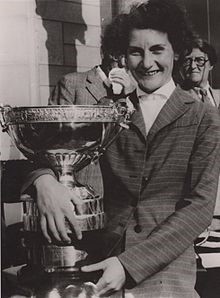
Moira Paterson was a Scottish amateur golfer who was born in Castle Douglas, Dumfries and Galloway. In the 36-hole final of the 1952 British Ladies Amateur Championship at the South Ayrshire town of Troon, on the west coast of Scotland, the 28 year old gym teacher, conquered the Lancashire born former champion, Frances ‘Bunty’ Stephens [1924-1978] of the Royal Birkdale Golf Club, at the 38th hole. The seven-hour match, held over the course at Troon, which did not become the Royal Troon Golf Club until 1978, was the longest British final on record. The match was watched by an enthusiastic crowd of around 2,000, when Moira’s sterling performance was one of true Scottish grit, since she was forced to receive daily treatment from a doctor after suffering a back injury earlier in the tournament. Early in the game Moira went five down, but never despaired and took lunch having whittled the deficit down to three. Immediately after lunch she soon went five down again, and with only 11 holes left to play staged a remarkable comeback to square the match at the 36th green. The resolute Moira buckled down to win after holing a two foot putt at the second extra hole, the first time in the entire match she had taken the lead.
Moira was also the runner-up in the 1949 French Women’s Open Amateur Championship, and represented Great Britain and Ireland against Belgium and France in 1949 and 1950 respectively. Moira also played for Scotland against Australia in 1949 and in the Women’s Home Internationals from 1949 to 1952.
In 1951 she reached the final of the Scottish Women’s Amateur Championship, held in the ancient fishing port and market town of Nairn, east of Inverness, but was beaten 3 and 2 by the former world number one, the indomitable Jessie Valentine.
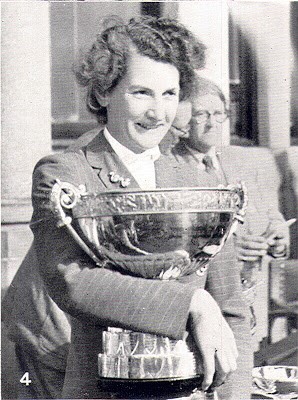
A contemporary of Jessie Valentine and the legendary Helen Holm [1907-1971], who won the Scottish Women’s Amateur Championship five times, and the British Ladies Amateur Championship twice. Reason enough why Paterson never got to see her name engraved on the Scottish trophy, and her record would almost certainly have been greater had the World War II not interrupted her career.
Moira was also a member of the triumphant Great Britain and Ireland Curtis Cup team at Muirfield in 1952, which scored a famous 5 – 4 win over the United States. Launched in 1932, it was Great Britain and Ireland’s first victory in the series.
Moira played out of the Gullane Golf Club at the time of the 1952 British Ladies Amateur Championship, where she was later made an honorary member. She was also an honorary member of the Lenzie GC at Kirkintilloch, Glasgow, and was at one time a member of Turnhouse GC in Corstorphine, near Edinburgh.
Moira lived in the village of Barnton, a suburb of Edinburgh to the north-west of the city, before moving south to England after her marriage, where she died aged 89 in a nursing home in Wells, Somerset.
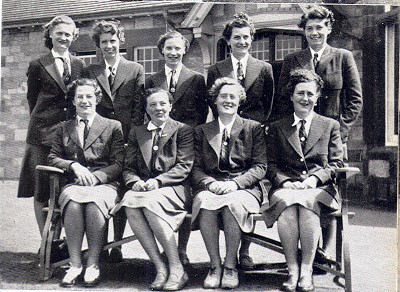
GB& I Curtis Cup Team 1952
Back row [left to right]: Philomena Garvey [Ireland], Frances Stephens [England],
Jessie Valentine [Scotland], Moira Paterson [Scotland], Elizabeth Price [England]
Front row [left to right]: Jean Donald [Scotland], Lady Katherine Cairns [Captain. England]: Kitty McCann [Ireland], Jeanne Bisgood [England].
In recent years great strides have been made to establish equality for women in most of the popular sports. Yet there remains much more to be done. For as sport begins to emerge from the ravaging consequences heaped upon it by the Covid-19 pandemic, forecasts cruelly predict a lasting damage to the positive progress made in female sport, with future funding likely to be adversely affected.
Surely it is the duty of all of golf’s governing bodies to ensure the sound progress made in establishing gender equality is adequately protected and is not tarnished.
Article © Roy Case
3,020 words. Roy Case July 2020

